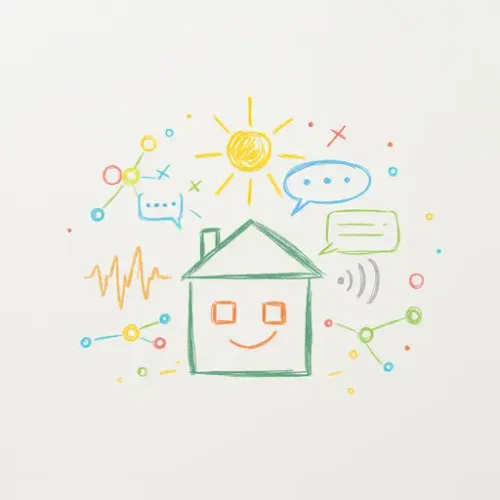Mastering Home Assistant's Dynamic Text-to-Speech for Proactive Voice Announcements

NGC 224
DIY Smart Home Creator
Mastering Home Assistant's Dynamic Text-to-Speech for Proactive Voice Announcements
Transform your Home Assistant automations from silent commands to engaging, auditory experiences. Text-to-Speech (TTS) allows your smart home to speak, delivering crucial information, timely reminders, or urgent alerts in a natural voice. This guide will walk you through setting up and mastering dynamic TTS announcements, enhancing your home's intelligence and responsiveness.
The Power of Voice: Why TTS Matters
Voice announcements offer an immediate, hands-free way to convey information that traditional notifications might miss. They cut through daily distractions, alert you to critical events when your phone isn't accessible, and provide an intuitive layer of interaction with your smart environment. Imagine security warnings, weather updates, or laundry cycle completion announced clearly and concisely.
Choosing Your TTS Provider: Cloud or Local?
Home Assistant supports various TTS providers, each with distinct advantages:
- Cloud-based (e.g., Google Cloud TTS, Amazon Polly): Offers superior voice quality, natural intonation, and extensive language support. Requires an internet connection and sends text to a third-party, with potential (often negligible) costs for high usage.
- Local (e.g., Piper, Home Assistant Cast): Prioritizes privacy (data stays on your network) and works offline. Generally free of recurring costs but might demand more Home Assistant server resources, and voice quality may vary.
For this guide, we'll detail Google Cloud TTS for its quality and ease, and briefly mention Piper for local enthusiasts.
Step-by-Step: Integrating Google Cloud TTS
Google Cloud TTS provides highly natural-sounding voices. Follow these steps for integration:
1. Prerequisites: Google Cloud Project & API Key
- Access the Google Cloud Console. Create a new project or select an existing one.
- Navigate to 'APIs & Services' -> 'Library'. Search for and 'Cloud Text-to-Speech API' and enable it.
- Go to 'APIs & Services' -> 'Credentials'. Click 'CREATE CREDENTIALS' -> 'API Key'. Copy the generated API key.
- (Recommended Security) Restrict your API key to your Home Assistant's external IP and the Cloud Text-to-Speech API.
2. Home Assistant Configuration
Add the following to your configuration.yaml file:
# configuration.yaml
tts:
- platform: google_cloud
api_key: YOUR_GOOGLE_CLOUD_API_KEY
language: en-US
voice: en-US-Wavenet-D # Select preferred voice
text_type: text
Replace YOUR_GOOGLE_CLOUD_API_KEY with your key. Save the file and restart Home Assistant.
3. Testing Your TTS Service
After restarting, navigate to 'Developer Tools' -> 'Services' in Home Assistant:
- Service:
tts.google_cloud_say - Target: Select a media player entity (e.g.,
media_player.living_room_speaker, Chromecast, or Home Assistant Companion App media player). - Message:
Hello, Home Assistant is now speaking!
Click 'CALL SERVICE'. You should hear the message. If not, check Home Assistant logs for errors and verify your API key and network connectivity.
Integrating Piper TTS (Local Option)
For a fully local, privacy-focused solution, Piper TTS is an excellent choice. It typically integrates via a Home Assistant Add-on or through HACS, using the Wyoming protocol for low-latency processing.
Installation: Search for 'Piper' in HACS (Integrations or Add-ons) or the official Add-on Store. Follow the specific installation and configuration instructions, which usually involve downloading a voice model. An example configuration snippet for configuration.yaml might look like:
# configuration.yaml (example for Piper)
tts:
- platform: piper
host: localhost
port: 10200 # Default Piper port
language: en-US
voice: 'en-us-amy-medium' # Example voice model
Restart Home Assistant and test using the tts.piper_say service.
Building Your First Dynamic Voice Announcement Automation
Let's create an automation that announces when someone arrives home, leveraging dynamic content.
Example: Welcome Home Announcement with Time
This automation uses Home Assistant's templating engine (Jinja2) to announce the arriving person's name and the current time on your main entry speaker.
# automations.yaml (or via UI automation editor)
- alias: 'Welcome Home Announcement'
trigger:
platform: state
entity_id: person.john, person.jane # Or a group of people
from: 'not_home'
to: 'home'
action:
- service: tts.google_cloud_say # Or tts.piper_say
data:
entity_id: media_player.main_entry_speaker
message: >
Welcome home, {{ trigger.to_state.attributes.friendly_name }}.
It's currently {{ now().strftime('%I:%M %p') }}.
This would produce an announcement like: "Welcome home, John. It's currently 05:30 PM."
Orchestrating Announcements: Volume & Prioritization
For a polished auditory experience, consider managing media player volume and handling multiple announcements.
# Example: Adjusting volume for an important announcement
action:
- service: media_player.volume_set
data:
entity_id: media_player.living_room_speaker
volume_level: 0.7 # Set announcement volume to 70%
- service: tts.google_cloud_say
data:
entity_id: media_player.living_room_speaker
message: 'Security alert! Motion detected at the front door!'
- delay: '00:00:05' # Allow time for message to play
- service: media_player.volume_set
data:
entity_id: media_player.living_room_speaker
volume_level: 0.3 # Reset to a lower background level
For advanced scenarios like pausing currently playing music, announcing, and then resuming, you might need to create more complex Home Assistant Scripts or explore specific media player integrations that offer advanced queue management.
Troubleshooting Common TTS Issues
- No Audio Output: Verify media player entity ID, device online status, and check Home Assistant logs for TTS service errors. Confirm cloud API keys are valid and enabled.
- Latency: Cloud TTS inherently has slight network delays. For local TTS, check your Home Assistant server's resource usage (CPU/network).
- Incorrect Template Rendering: Use the 'Developer Tools' -> 'Template' editor to pre-test Jinja2 templates for syntax and correct data retrieval before deploying in automations.
Best Practices for a Harmonious Auditory Smart Home
- Be Concise: Keep messages brief and to the point to avoid annoyance.
- Prioritize: Use TTS for important alerts or reminders, not every minor event.
- Contextualize: Leverage templates for specific details (e.g., "Living room window is open" vs. "A window is open.").
- Manage Volume: Adjust announcement volume based on time, occupancy, or alert criticality.
- Avoid Fatigue: Implement conditions (e.g., `for: 30s` on state triggers) to prevent repetitive announcements.
- Test Thoroughly: Always test new automations in various real-world scenarios.
Real-World Use Cases
- Security & Safety: "Motion detected in the backyard!" "The smoke detector in the kitchen has activated!"
- Reminders & Productivity: "It's 8 AM, time for your daily briefing." "The dryer has finished its cycle."
- Environmental Awareness: "The temperature in the baby's room is now 20 degrees Celsius."
- Visitor & Delivery Notifications: "Someone is at the front door." "A package has been delivered to the porch."
- Energy Management: "The electric car has finished charging."
Conclusion
Integrating dynamic Text-to-Speech into your Home Assistant automations is a powerful way to make your smart home truly interactive and proactive. By carefully configuring your chosen TTS provider, crafting intelligent templates, and adhering to best practices, you can create a more intuitive, informative, and responsive living environment. Start exploring the possibilities of a speaking smart home today!

NGC 224
Author bio: DIY Smart Home Creator
